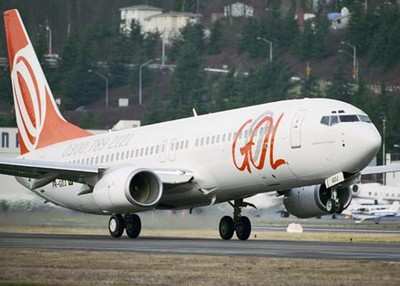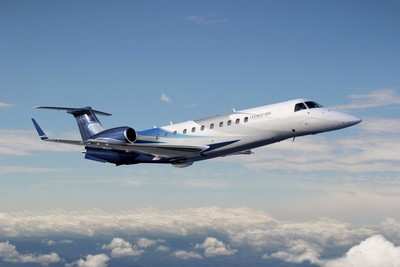Board Says ATC At Fault, Brazil Also Points Finger At US
Pilots
 None
of the following is particularly surprising, really... but it is
intriguing. In their separate reports, the National Transportation
Safety Board and the Brazilian Air Force cast blame for a September
2006 middair collision over the Amazon on different parties, which
-- intentionally or not -- also fall down distinctly nationalistic
lines.
None
of the following is particularly surprising, really... but it is
intriguing. In their separate reports, the National Transportation
Safety Board and the Brazilian Air Force cast blame for a September
2006 middair collision over the Amazon on different parties, which
-- intentionally or not -- also fall down distinctly nationalistic
lines.
As ANN reported earlier this week, Brazilian
officials placed much of the blame on the two American pilots of
the Embraer Legacy 600 that collided with a Gol Airlines 737 on
September 29, 2006. Air force investigators said those pilots
inadvertently switched their transponder to standby mode... taking
the plane off controllers' screens, and rendering the plane
invisible to the TCAS system onboard the airliner.
The planes collided nearly head-on along the same airway at
FL370. The Legacy was able to make an emergency landing... but the
Gol 737 spun into the forest, killing all 154 persons onboard.
The Brazilian report specifically notes the Legacy's CVR
recording an "exclamation" from copilot Jan Paladino within seconds
of the impact, presumably upon the realization the transponder was
in standby mode. After several seconds, Paladino said, "I'll do
that, I got that," and the transponder was switched on, once again
lighting up the plane on controllers' screens.
Brazilian investigators also found the country's air traffic
controllers shared a large percentage of blame for the crash,
stating ATC failed to realize the Embraer was on a direct intercept
course with the airliner, at a non-standard altitude for a
northwesterly flight.
But the tone of the report clearly indicates Brazilian officials
feel had Paladino and captain Joseph Lepore been more cognizant of
their surroundings, and more familiar with their airplane, the
collision would not have happened. That differs significantly from
the NTSB's take on the accident, issued Wednesday concurrently with
the Brazilian findings.

In its 282-page report on the accident -- parts of which are
redacted -- the American safety body says Brazilian controllers
shoulder nearly all of the responsibility for the accident, as they
issued both aircraft "clearances which directed them to operate in
opposite directions on the same airway at the same altitude
resulting in a midair collision.
"The loss of effective air traffic control was not the result of
a single error, but a combination of numerous individual and
institutional air traffic control factors, which reflected
systematic shortcomings in emphasis on positive air traffic control
concepts," the Board concluded.
 The NTSB
noted the non-operating transponder as a contributing factor to the
crash, and issued a recommendation that louder, more noticeable
alert systems be installed onboard commercial aircraft, to warn
pilots when transponders are inactive. The Legacy's Honeywell-built
system only issued a small warning message on the plane's crew
alerting system, which was apparently ignored.
The NTSB
noted the non-operating transponder as a contributing factor to the
crash, and issued a recommendation that louder, more noticeable
alert systems be installed onboard commercial aircraft, to warn
pilots when transponders are inactive. The Legacy's Honeywell-built
system only issued a small warning message on the plane's crew
alerting system, which was apparently ignored.
David Rimmer is executive vice-president of US-based ExcelAire,
the company that employed Lepore and Paladino to deliver their new
Legacy 600. He was onboard the bizjet when it collided with the Gol
737... and told Newsday that Brazilian investigators took "the easy
way out" on purpose.
"I was on the airplane, so it's a personal thing for me," he
said. "Brazilian air traffic control pointed two aircraft at each
other for an hour . . . Brazil's report is a cover-up of Brazilian
air traffic control's systemic problems."
Nationalistic interests aside, there's little dispute about the
serious deficiencies that exist among Brazil's ATC network,
including spotty radar coverage and labor issues among the
workforce, which is comprised of air force personnel.
In late October 2006 -- one month after the Gol tragedy -- air
traffic controllers launched a work-to-rule campaign, deliberately
slowing operations, due to concerns about working conditions and
new safety procedures implemented as a result of the mid-air
collision. Controllers struck their jobs outright in March this
year, bringing the nation's air travel network to a halt for
several days.
Lepore and Paladino were detained in a Rio de Janeiro hotel for
over two months following the accident. They were allowed to leave
Brazil in December 2006, but not before being charged by police for
"endangering air safety." Though a Brazilian judge absolved both
men of any charges of negligence, they still face endangerment
charges if they ever return to Brazil.

Paladino continues to work for Excelaire. Lepore now flies for
American Airlines, according to the New York Times
 ANN's Daily Aero-Term (05.10.24): Takeoff Roll
ANN's Daily Aero-Term (05.10.24): Takeoff Roll Aero-News: Quote of the Day (05.10.24)
Aero-News: Quote of the Day (05.10.24) Aero-News: Quote of the Day (05.11.24)
Aero-News: Quote of the Day (05.11.24) ANN's Daily Aero-Term (05.11.24): IDENT Feature
ANN's Daily Aero-Term (05.11.24): IDENT Feature ANN's Daily Aero-Linx (05.11.24)
ANN's Daily Aero-Linx (05.11.24)






